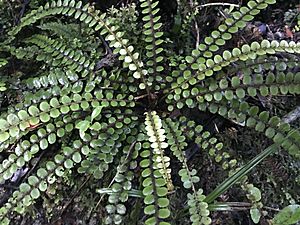Cranfillia fluviatilis facts for kids
Quick facts for kids Cranfillia fluviatilis |
|
|---|---|
 |
|
| Scientific classification | |
| Synonyms | |
|
Cranfillia fluviatilis, also known by its older name Blechnum fluviatile, is a type of fern. In the Māori language, it is called kiwikiwi. This plant is a "hard fern" that belongs to the group Cranfillia in the Blechnaceae family. Patrick Brownsey officially identified this fern in 1979.
What it Looks Like
The leaves of Cranfillia fluviatilis are called fronds. These fronds can grow up to 50 centimeters (about 20 inches) long. This fern grows in a special way, forming a circular pattern of leaves close to the ground. This shape is called a rosette.
Some of the fronds are dark brown and spiky. These are called fertile fronds because they produce spores, which are like seeds for ferns. They stand upright from the center of the plant. Other fronds, called sterile fronds, have rounder leaflets and droop downwards, forming the rosette shape. As the fern gets older, it can grow a short trunk in the middle. This trunk is often surrounded by a group of new ferns growing nearby.
Where it Grows
The Cranfillia fluviatilis fern is quite tough and needs damp, shady places to grow best. This small fern is native to New Zealand and the southeastern parts of Australia. It is very common throughout New Zealand in wet, shady spots. You can often find it in acidic, moist, or boggy soil, especially next to streams in forest areas.
This fern species grows in many of New Zealand's forests. This includes much of the forested area of the North Island, and the west, north, and south coasts of the South Island. It also grows on Stewart Island/Rakiura. In Australia, it can be found in parts of the coastal forests of the southeast. For example, on Stewart Island, it often grows alongside another fern called Austroblechnum durum.
A Bit of History
This fern was first collected by William Colenso in December 1841. He found it in the woods near Poverty Bay on the North Island of New Zealand.

